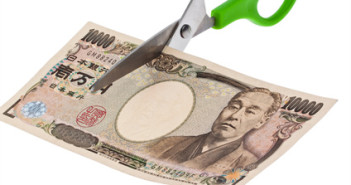Historically consistent strong trend in the Yen
Japan has traditionally been a net exporter of high-value goods, thereby running up huge trade surpluses. The foreign earnings of Japanese companies surpassed the earnings of foreign companies in Japan, thereby ensuring that the demand for the Yen far exceeded the supply.
For decades, Japanese government bonds have been very popular among the Japanese investors. This supported the strengthening of the Yen. After the recent Quantitative Easing in the US and the sovereign debt crisis in Europe, Japanese assets seemed to represent the safest investment option to foreign investors too. This further fuelled the demand for the Yen, making it continue to go up against the dollar. Also, interest rates having fallen in the US following the economic crisis of 2008 has led to a reduction in the interest rate differential between the US and Japan, thereby discouraging the Yen carry trade. This also contributed to strengthening of the Yen against the USD.
Recent changes in political stance weakening the Yen
In Nov. 2012, for the first time since 1981, Japan reported a current account deficit. By this time President of the LDP Mr. Shinzo Abe, who was heavily tipped to become the next prime minister of Japan, had started his campaign pledging fiscal and monetary steps to revive the economy, bring the deflationary trend under control and weaken the Yen. Mr. Abe proposed aggressive monetary easing and increased public spending – in the form of a 12 trillion Yen fiscal stimulus package – as the key steps to achieving these goals.
Abe also announced his plans to resurrect the Council on Economic and Fiscal Policy (CEFP), a government advisory body which gained prominence during former LDP Prime Minister Junichiro Koizumi’s term. The CEFP played a significant role in facilitating Koizumi’s privatization and deregulation agenda during 2001-2006, but had fallen into dormancy during the last DPJ tenure in Japan. Under the aegis of the Abe government the CEFP is expected to help influence the BoJ into loosening its monetary policy.
The above moves have resulted in a more than 11% tumble of the Yen against the dollar between November and December 2012.
What does the market think?
In a recent article on his expectations from 2013 Jim O’ Neill, Chairman, Goldman Sachs Asset Management expressed his confidence in Mr. Abe’s measures to force the Bank of Japan into chasing a genuine 2% inflation target, which would lead to a further weakening of the Yen. Traders in the USDJPY market are keenly awaiting the 22nd BoJ meeting to see whether they adopt a 2% inflation targeting.
How can you benefit?
Many short term technical charts suggest that the Yen is slightly oversold, and the market might see some short Yen covering in the shorter term. But, over the medium term, this looks like a major trend reversal. The Japanese economy has been stuck into a downward spiral of stagflation for the last couple of decades. Add to that the ageing demography and extremely high debt to GDP ratio of 200%+, which would put debt crisis ravaged Southern Europe look rosy. As WSJ points out, a section of Japanese industry leaders are themselves speculating on the Yen tumbling even further. And a genuine 2% inflation targeting might mean USDJPY heading towards 100 in the next few months.
If you’re a trader planning to trade USDJPY, given the current high levels of volatility you would find a widening of spreads, hence make sure you choose a trading platform that offers you the tightest spread. Also, keep in mind the margining that your broker allows you to have; which directly translates into how much more you make or lose. Don’t forget to add stop losses, and be prepared to cut your position if the JPY strengthens. Keep your fingers crossed and enjoy the roller coaster ride ahead.



